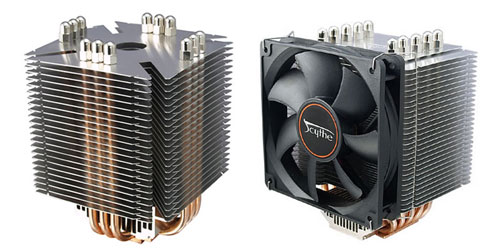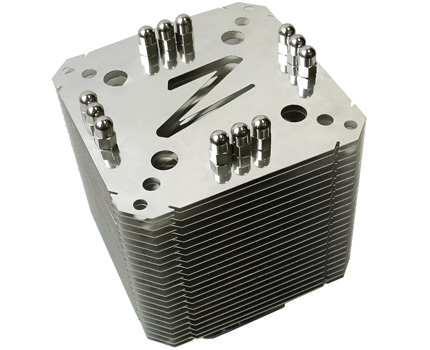Scythe Ninja Plus Rev. B: Updated Cooling Legend
by Wesley Fink on April 11, 2007 2:00 AM EST- Posted in
- Cases/Cooling/PSUs
In the past the Ninja name was used to designate the top-of-the-line Scythe coolers. Then somewhere along the development road the Infinity name rose to the top of the Scythe catalog. In the current Scythe lineup the two coolers are remarkably similar in features, but with slightly different design approaches to the cooling task.

While both the Ninja and Infinity use 6 heatpipes for cooling in a tower arrangement, the Infinity is wider than it is thick and groups the heatpipes on the two sides of the fin array. The Ninja, on the other hand, is square with three in-line heatpipes on each side of the square. One purpose of this review is to determine which of these design approaches is the most effective in cooling.

It was also pointed out in our recent review of the OCZ Vindicator that the Vindicator looked like a relabeled Ninja Plus Rev. B. Looks, however, can be very deceiving and benchmarking the Ninja Plus B should provide better answers to the question of how similar the OCZ Vindicator and Ninja Plus B actually are. If the Ninja Plus B performs much better or much worse than the Vindicator tested with the same fan, then it is reasonable to assume the designs are really different. If performance is virtually the same, then it is reasonable to conclude that these are likely the same base cooler.
There is no getting around the fact that the Scythe Ninja Plus B is a big cooler. Most of the heatpipe towers are huge, which is part of why they are effective. The good news is the fin array is raised enough that it clears the power transistor passive coolers, heatpipes, caps, and fans on every board we had in the lab. This even includes fitting on the ASUS Striker and Commando boards, which can be a challenge with their raised heatpipes and passive cooling sinks surrounding the CPU socket. There's not any room left on these ASUS boards to fit hands between the heatpipe ring of the board and the fin array of the Ninja Plus B, but you can mount and unmount the Ninja Plus B if you are careful and first remove the motherboard from the case.

While both the Ninja and Infinity use 6 heatpipes for cooling in a tower arrangement, the Infinity is wider than it is thick and groups the heatpipes on the two sides of the fin array. The Ninja, on the other hand, is square with three in-line heatpipes on each side of the square. One purpose of this review is to determine which of these design approaches is the most effective in cooling.

It was also pointed out in our recent review of the OCZ Vindicator that the Vindicator looked like a relabeled Ninja Plus Rev. B. Looks, however, can be very deceiving and benchmarking the Ninja Plus B should provide better answers to the question of how similar the OCZ Vindicator and Ninja Plus B actually are. If the Ninja Plus B performs much better or much worse than the Vindicator tested with the same fan, then it is reasonable to assume the designs are really different. If performance is virtually the same, then it is reasonable to conclude that these are likely the same base cooler.
There is no getting around the fact that the Scythe Ninja Plus B is a big cooler. Most of the heatpipe towers are huge, which is part of why they are effective. The good news is the fin array is raised enough that it clears the power transistor passive coolers, heatpipes, caps, and fans on every board we had in the lab. This even includes fitting on the ASUS Striker and Commando boards, which can be a challenge with their raised heatpipes and passive cooling sinks surrounding the CPU socket. There's not any room left on these ASUS boards to fit hands between the heatpipe ring of the board and the fin array of the Ninja Plus B, but you can mount and unmount the Ninja Plus B if you are careful and first remove the motherboard from the case.










36 Comments
View All Comments
crimson117 - Wednesday, April 11, 2007 - link
Also included are pictures of compatible ninjas.
bigpow - Wednesday, April 11, 2007 - link
I bought the Ninja a while ago (I think AT article helped make that decision for me)I'm glad to know that AT cares about its readers
Eventhough the Ninja is old (and probably doesn't make sense for new system build), a lot of us still have them and it's nice to know that the old Ninja still has what it takes.
The suggestion to replace the S-Flex fan is also very nice.
Thank you
Talcite - Wednesday, April 11, 2007 - link
You guys mentioned that you were looking for a quiet PSU for the testing rig...At SPCR, everyone uses the Seasonics S12s and M12s for silence. I personally have a S12-430W and it is very quiet. I sleep less than 2 feet away from my system and can barely hear it. I haven't heard the M12 personally, but it should be near silent anyways. Maybe you guys should look into the Seasonics?
Gary Key - Wednesday, April 11, 2007 - link
We will be testing several power supplies over the next couple of weeks but at this point the Seasonic based Corsair 620HX is the leading candidate for this test scenario based on the units we have on-hand.fic2 - Wednesday, April 11, 2007 - link
Hopefully you will test the SilenX PS, too. If their PSs perform anything like their fans they should be good. Website: http://www.silenx.com/ixtremapropsus.asp">http://www.silenx.com/ixtremapropsus.asp.jay401 - Wednesday, April 11, 2007 - link
Good review and definitely appreciate this recent spurt of HSF reviews. Looks like the Ultra 120 Extreme is the way to go... if indeed they've revised their mounting bracket for S775. Do you have any confirmation of that?Btw two quick typos: Page5 - first graph "iis", Page7 - paragraph ending with word "solution" has no period after it. =)
Wesley Fink - Wednesday, April 11, 2007 - link
You have exceptional editing skills. Thanks for pointing out the typos. Corrected.No word yet on a modified S775 bracket for the Ultra 120 Extreme, but we will ask Thermalright again.
jay401 - Wednesday, April 11, 2007 - link
Journalism degree/geek :DThanks for planning to follow up with Thermalright; I doubt I'm the only potential buyer of their performance-topping design who would like to know if the product can now be installed without bending tensioning brackets. ;)
dm0r - Wednesday, April 11, 2007 - link
and also ask thermalright the new cpu cooler they made....IFX-14. It really looks promising. Thanks for the review!Brunnis - Wednesday, April 11, 2007 - link
So, how are we going to compare the effectiveness of these coolers when you seem to have used different fans? I can see the point of testing with stock fans (if applicable), but the thing most people want to know is which heatsink that performs the best. Your heatsink reviews also seem to be geared towards heavy overclockers, in which case testing with the stock fan makes even less sense. You don't even provide RPM figures for the fans used on the different coolers.I'm sorry, but I just find these reviews pretty much pointless. The testing methodology is flawed, considering the group of users that you're targeting.